This wonderful swirling mass of tiny Starlings is called a murmuration. Apart from being mesmerisingly beautiful or terrifying – depending on whether or not you’re an Alfred Hitchcock fan – the phenomenon has been studied by lots of different sorts of people. You’d probably assume they were Ornithologists, some Biologists maybe, but Physicists, Mathematicians, Cryptographers, Neuroscientists and Computational Modelers, may not have leaped immediately to mind.
There are various hypothesis for why the Starlings bother: avoiding and confusing predatory birds; the best way to spot another sexy Starling; and even to reinforce social cohesion in a flock which has a better chance of thriving genetically, as whole rather than as individuals. There are other ideas, some considerably more plausible than others – quantum field theory!! Anyway, no matter which angle they came from, the clever people pretty much all now agree that these incredibly complex patterns emerge from a few very simple underpinning rules. Essentially, each individual Starling in groups that can extend up to hundreds of thousands of birds, all do the same thing at the same time:
- Match Speed (with your immediate neighbours)
- Don’t Collide (leave just enough space to manoeuvre)
- Head to Centre (of the nearest greatest mass)
There are some very clever mathematical models that enable some virtual birds on a screen to mimic the shape of a murmuration, just from those rules (and some coding witchcraft). Mimic is an important word, because although the patterns in the air and on the screen look similar – both to the eye of a casual observer and to intricate statistical mapping – you cannot intentionally design or predict the movements of an actual flock in the real world, or for that matter, any individual real or virtual bird beyond a very very narrow moment in time.
But here’s what will really cook your noggin… despite the three rules being unequivocally right… not a single Starling knows the rules. Not one, none of them are thinking of the rules and there’s little chance of any of the birds even thinking left a bit, down a bit, faster a bit, because those are human concepts. Arguably that’s what their little birds brains are doing in some sort of anthropomorphic hypothesis, but most importantly no special birds lead the others. They will all simply join in, applying the rules perfectly which are, to all intents and purposes, written deep into their genes. Although we can similarly anthropomorphise some intentionality or ultimate goal to the behaviour, in truth, Starlings don’t write plans beyond that which all living things share… to keep going.
So why am I talking about Murmurations?
For many years, I’ve been involved in helping people to get better at whatever it is, that they do. I started by being sent in to investigate stuff that had already gone wrong and in doing so, one typically starts by delving into the murky world of the decisions and actions leading up to the event in question. Fortunately, I’ve been around long enough and been helpful often enough, to now be invited in before things go wrong, to help people keep it that way. In doing so, you inevitably move from evaluating the effect of past decisions and actions, to studying how those people who join in, may in future scenarios, get even better at, joining in. Sounds very clever, but it’s essentially exploring the same boring motivation as the Starlings, to do your best in order to, well, to keep going.
Saying that, lots of lovely people have invested entire lifetimes in trying to work out why people keep going, from various Theologists passing a deified buck, through all sorts of Arts, Sciences and Humanities searching for the true meaning of life. I’m with Douglas Adams on most of it, but I do appreciate some of the more useful attempts and just to prove it, you can read my thoughts on Maslow and that bloody pyramid, by clicking on the picture:

Equally impressively, over the past 30 years, a few splendid explorers with their Functional Magnetic Resonance Imaging, have been zooming in on the individual neurons (birds) and then, panning out to the figurative assemblies (murmurations) of neurons that join in, to make manifest, the mind within the brain. My favourite go to on that malarkey is Baroness Professor Susan Greenfield. That’s another Saturday easily lost under wireless headphones doing some deep learning, while surreptitiously appearing to be just cooking a curry. Even in this little snippet, she drops half a dozen lovely truth-bombs, but concentrate on the phrase at 4:38!
I thought to myself, rather than trying to determine the #why of peoples behaviour, a sort of macro-purpose like Maslow and instead of trying to figure out the #how of the micro-mechanisms like Greenfield, perhaps I could figure out where they both meet, sort of #now and at meso-practice level. Like a set of Starling rules, but for humans? Talk about setting yourself up to get all tied up in knots, with all sorts of professors of stuff I couldn’t hope to follow without a contemporaneous screen full of Wikipedia.
To cut a very long story short (the PhD is not finished), I ended up watching groups of people doing what they do. I mostly live in the world of health and social care, so I got to see a great deal of deep technical insight alongside equally wonderful skills, brought together around incredibly powerful but practicably simple, enduring acts of kindness.
I asked lots of different practitioners how they do what they just did and inevitably, a few of them post-rationalised a process that they clearly didn’t actually do at the time. I explained to lots of people what I saw them do and helped a few work back over the cognitive processing that underpinned their actions. It was here that I realised how few people could answer the question: what is it that they do, when it’s not a process? They all pretty much, instantly nod, wide eyed, when I suggest it might be called, an experience.
I had to read Thinking Fast & Slow, Sources of Power, Intuition Pumps, A Day in the Life of the Brain and Deceit and Self-Deception all at the same time, twice, to work that out. There’s a stadium full of guru’s out there but I ended up wandering around in some very obscure corners of the cutting edge, in fields I never knew existed. It was painful but worth it, if only to find a few less celebritist nerds in various dark corners nearby, who freely gave away loads of loveliness about the connection of thinking and doing; sophia and phronesis; theory and practice. I’ve developed a proper crush on Occupational Therapists.
What has Occupational Therapy got to do with it?
The best term for this connection that I’ve found so far, for how people do stuff, is Praxis. Yes I know, that old carrot. Much of this malarkey leads one inevitably down the path of decision science, and the multimillion dollar industry around decision support.
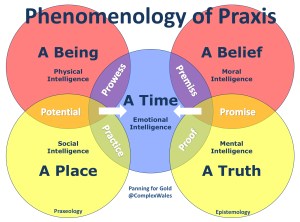
But that is not what I am after: I’m more interested in what people do, how they occupy their time, perhaps. It’s not quite philosophy and psychology, nor anthropology and praxeology, but the glue in between, the rules, the pattern that makes us all sort of bother to naturally… keep going. When you’re finding it hard to keep going, the best person you could possibly meet is an OT.
There are loads of lovely people, unlike me, making lots money in this arena. I love the way Dave Snowden describes Cynefin, in the analogy of a children’s party. That liminal zone is becoming Cluedoesque in the equally soothing as frustrating, anticipation of its final manifestation. It was Dave in the Study, with the Ontology.
Consequently, I’ve recently been absorbed by Dave’s exchanges with Simon Wardley and his lovely Twitter monologues, designed to debunk dogma. His Wardley Maps have an implied temporal axis that Cynefin lacks, but equally, when trying to interpret those lovely diagrams, I’m sure the uninitiated have trouble telling shit from custard with all those lines. The temporal maps lack the neatly bounded applicability of an Ontology, but interestingly I think both techniques help people to develop Tactics – or overcome the predisposition of Leaderists to desperately try and avoid admitting, that they have absolutely no idea what to do!
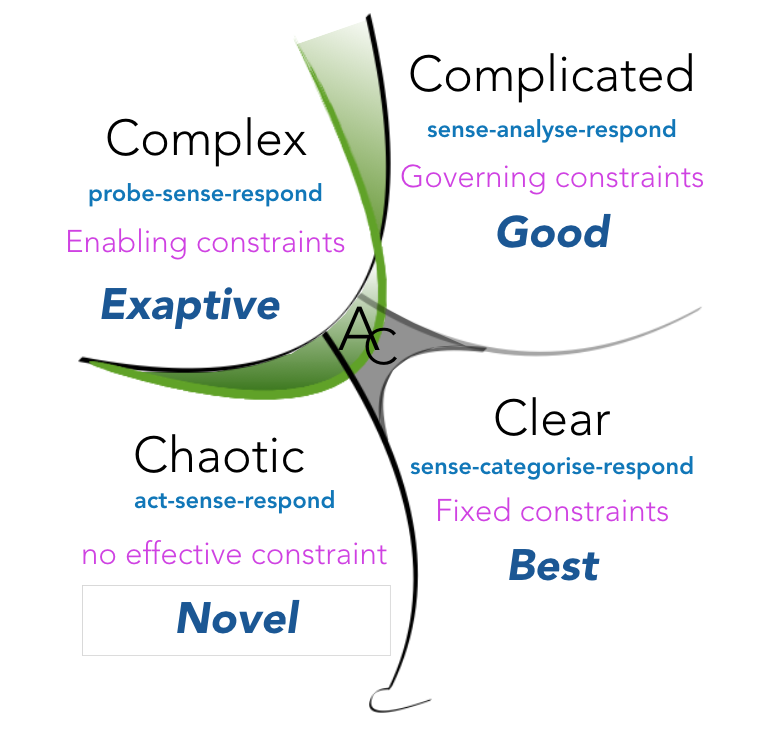
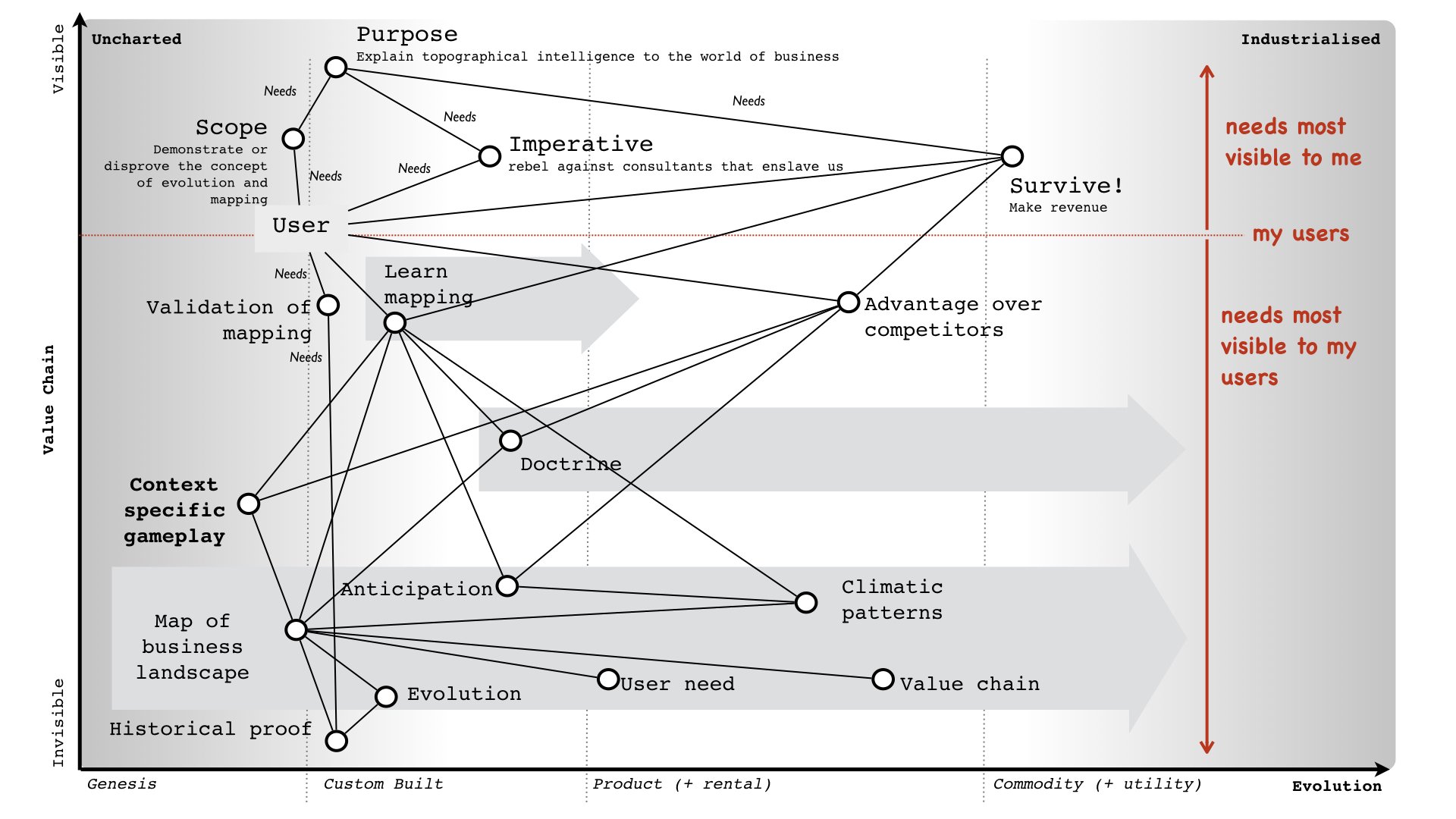
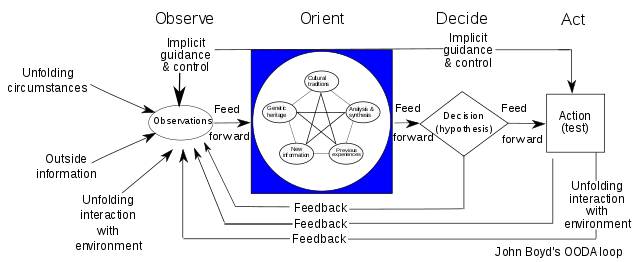


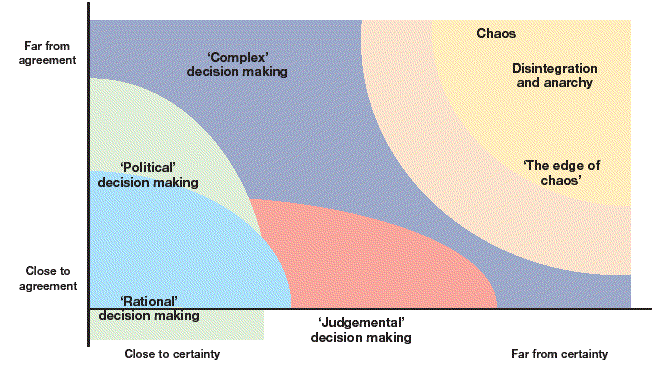
This is not new territory either, with John Boyd (OODA), Chris Argyris (Double Loop), Ikujiro Nonaka (SECI) and Ralph Stacey (Matrix) as some of the more obvious people in the space. Notwithstanding that I found loads of absolute nuggets in the work of many other, less well known people, busy Tinkering with Thinkering.
I suddenly feel the need for a short bloggy interlude to let my Impostor Syndrome out to take a bow. Apart from having a couple of Architecture Degrees – and a brain that draws isometric explosions of things without me having to get involved – my only real intellectual contribution to the world is understanding a little bit about how people represent things and ideas. Less Representationalism more Representography (that’s a made up word), so here goes, you’re about to get an abstraction or metaphor, for what happened when brain drew, on her own and without my permission, a picture of people, keeping going.
Brace yourself!
Doing human, as opposed to just being human, is like riding a big swing. You deliberately plonk your bum down and grab hold of the ropes intending to do something. Then you kick back, leaning forward as the swing moves backwards, until it slows to a comforting pause and you hold tight, feel the tension in the rope, lean back and as it starts to swing forward, you kick out your legs to a new high point, where you slow, look into the sky feeling momentarily light and then gradually as the world gets smaller, feel the weight build as you comfortably glide back skimming the ground, only to be set, ready, at a new high, looking forward, gripping the rough rigid rope, ready to go and then really kicking out those feet and going for it. At this point the bravest people in my playground even let go of the ropes and flung their arms out wide, having faith in the universe to do its thing.
Who hasn’t at least once, instantly regretted that split decision to jump?
@complexwales
You start by recognising where you are (1) kicking back in time to familiar territory to look at your world and check stuff out (2) you swing forward in time to get a sense of what could be (3) ahead of pulling back under full control (4) to swinging past the moment and letting it go (5).
- Look up (recognise your 5, is in a place and at a time)
- Spot bother (we’re brilliant novelty receptors, when 1 is on)
- Sense direction (we’re better at avoiding 2, than copying 4)
- Take a step (do something, immediately useful to 5)
- Carry on… (until someone points out, it’s time for a 1)
The Starlings match speed, don’t collide, head to centre without knowing the rules and I’ve been modelling humans, doing almost exactly the same. Albeit, that our rules are slightly more conflated, interfered with by some bloody thing called consciousness and our natural tendency to materially lack any sense of having it, most of the time.
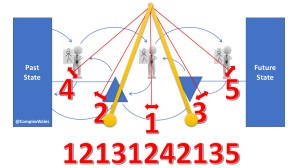
So I ended up sitting back and watching crowds of people, perfectly applying a few rules to which they are mostly completely oblivious. But perhaps even more interestingly, the pattern goes: 12131242135. Several geeks have just exploded in a Fibonacci Incident centred on the appearance of 4. Cybernetically, it’s not really a 4, it’s a 1 the same as 2 is really a 1. It’s the 35 that makes them go 🤯 Bang!
Trouble is, unlike the playground, the swing used in Praxis, is also a time machine, and a maladjusted one, with a mind of its own. It’s like riding some sort of Spacetime Traversing Existential Liminal Swing around every moment you inhabit: heavy and dependable on the back swing into the last moment but light and ethereal as it throws you forward into the next moment.
In fact, so fluffy on the final forward swing that you’ve got little chance of swinging back at all… suddenly aware that you’ve already lept forward into the next moment, sat there, holding the ropes, ready to kick back. Bang!
Hang on, where the hell is this going?
I’m not entirely mad and I’m the first to admit that the Spacetime Traversing Existential Liminal Swing is not a sticky idea. But arguably the biggest problem with the swing metaphor, is that it often draws forth an image of something static and linear. However, your swing is itself rolling through time, as you swoosh slightly backwards into memory and slightly forwards into imagination. It’s like your personal praxis-swing is on wheels and even then more shopping trolley casters, than neat railway lines. So on the backswing into familiarity, you can occasionally feel as totally disrupted, as you can on the forwardswing into novelty, suddenly feeling right out on a limb… as the whole universe seems to change direction underneath you.
By the why, I’ve also worked out that the Macro (Why) and the Micro (How) follow exactly the same pattern, just operating on a different temporal scale. It’s a spacetime thing and now I’m sure you think I’m mad, but honestly the blame for all this lies firmly on the shoulders of Ashley. He politely asked me to expand on this tweet and look what happened:
In short, I’m conveying a very old design principle: if you’re trying to design something and finding it ridiculously hard, it’s a sure sign that you’re not ready to design it. Go learn something new, have some chips covered in cheese, drink wine, talk to people you don’t know, watch an old film, stare out of the window picking your nose, or my personal favourite; sit in the darkest corner of a shit pub and listen to numpties talking passionately about bugger all. Then quietly work out how the bugger all, could possibly and obscurely, relate back to your complete lack of progress.
As Edward Debono tried to explain in three different books: you’ll eventually realise that all that stuff is itself progress, in sending your brain off laterally into the future, swinging sideways, so to speak. So in response to Ashley, if you’re struggling with goal planning, it’s a sure sign that goal planning is the wrong thing to do (no matter which acronym).
A Grand Plan
In other words, a grand plan is nice, comforting even, but not enough of the world is under your control to play out those sorts of plans; and that’s despite your natural inclination (cognitive bias) to believe that whatever you got, is what you planned all along. People waste time lost in hope, in some future illusion rather than taking ahold of what they can actually control right now. There is no goal, other than to keep going and even if you make a brilliant plan, the only way to enact it is to… keep going.
I wish I had a pound for every time I’ve pointed out that despite, knowing where you’re going, being soothingly reassuring… you’re never going to get there, if you don’t know where you are.
@complexwales
Don’t get me wrong, if you’re building a massive bridge then have a bloody good plan. The whole point of a plan is to communicate a list of loads of stuff to do, when there’s loads of people doing it and you should Prince II Project Management Gantt Chart, the arse out of it. Fortunately, most of life and work is not like that, and what’s more with my Architect hat on, most of the stuff that is like that, doesn’t actually work like that either.
Anyway, a long time ago in theoretical maths class, I became besotted by the idea of Nested Systems. I think it was the ecological thingamajig that every living thing is made up of and produces, what it is made up of and produces. I think that’s what brain latched onto when she did this. So here it is, this is how we actually keep going – arguably from micro to macro and from moments to millennia – but I found it, in meso and in minutes and in some utterly amazing people, caring for each other and keeping going.
Knowing how to use this strange little looping pattern, opens up all kinds of interesting ways of representing the world. The systemic model of Flow, the Commissioning Method CAREMORE and the patient risk matrix ANGEL (all found on this blog) are just three examples and there are loads more.
Finally, whether thinking about the loops or the swing, future is an important concept and arguably the whole reason for evolving a conscious brain in the first place; time traveling. To draw forward into the moment things from your past, in order to effortlessly launch yourself into the future, or at least imagine what the next few moments may be like. And may, in this sense, is probably the most difficult concept in the whole universe, to get your head around and that’s in a blog entitled: Spacetime Traversing Existential Liminal Swing.
Unless of course you’ve already worked out why 12131242135 is actually 21232111235. In which case, you’re clearly as mad as me 🤯 Bang!


Excellent. I think I feel a bit like a starling that has had something explained to it.
LikeLike
Thanks! A compliment indeed.
The most leverage I get out of the idea, is helping someone whose got stuck in one of those circles. Trying too hard, buried in process, unaware, confused and worst of all constantly in fear of the uncertainty of the next moment. Just got to sit on your swing next to them for a while and the let the rules kick in.
LikeLike
Can’t tell you how important and timely this is and I know, it’s been sat in the back of your head for decades! Ta
LikeLike